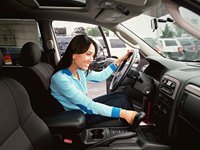8 foolproof tips for women test-driving cars

Driving around the block does not constitute a test drive. How much information can you honestly glean from five minutes in the car? And yet, that is exactly what most dealerships ask you to do when trying out their vehicles. Don’t let that happen.
It takes at least 30 minutes to adequately size up a car. Do not let the salesperson control this transaction. You are the one spending the money, you are the one who will say when the test drive is over.
It is necessary to test out several brands on a single day so you can evaluate them back-to-back and the comparison will be fresh. Follow these tips to fully assess a car’s attributes.
And take this checklist with you to the dealership so that you won’t forget what to look at.
1. Interior comfort: Get in and out of the car several times to see how easy it is to access the driver’s seat. Do you bump into anything? Now play with the seating controls. Get into a proper driving position. Can you easily reach the pedals and still keep a safe distance from the steering wheel? Does the steering wheel tilt and telescope in and out. Is the driver’s seat comfortable? Now sit in all the passenger seats, and ask any friends and family who came along to give their assessment of passenger comfort.
2. Storage space: Do you regularly haul a lot of stuff around? Bring sporting gear, child safety seats, golf clubs, pet carriers, strollers and even luggage with you. Now load up the trunk or cargo space. The point is to see how the things you use on a daily basis will fit. If your gear doesn’t fit, you can stop the test drive and move on to your next vehicle choice.
3. Touch everything: Though one of the reasons you may purchase a particular car is for it’s snazzy exterior looks, the truth is, you live INSIDE of the car. So touch all the surfaces. Are they appealing to look at, as well as to touch? Or does the car have so much hard plastic that it’s ugly and off-putting? Now open all the storage compartments. Is there a convenient place for your cell phone to charge? How about your sunglasses, your purse or briefcase, or coins, if you happen to travel on a toll road? Check to make sure you like the interior storage configurations.
4. Time to cruise: Here’s where the salesperson is likely to rush you. Be strong. You’re in the driver’s seat now. Take the vehicle to a nearby shopping mall. Park the car in a tight spot. Can you see all four corners of the car so that you know how close you’re getting to other vehicles? Now back out of the parking space. How are the blind spots? Do you have adequate visibility on all sides so that you don’t fear hitting a passing pedestrian? And if the vehicle has a back-up camera, check for its clarity and scope. Does it have a wide field of vision? But don’t rely solely on the camera. You still need to look both ways with your own eyes before you back out of any space. Never use a back-up camera as a crutch.
5. Scare the salesperson: Now drive to a quiet side street that has little traffic. See how well the car does a U turn. How is the turning radius? If it’s not so great, will that bother you over time? If so, stop the test drive and move on. If it’s ok, then try out the brakes. Accelerate to about 40 km/h and slam hard on the brakes. Does the car stop quickly and surely? Did you feel safe in that emergency maneuver?
6. Hit the highway: Now, you’re ready to go at highway speed. Find the nearest highway onramp and get on the gas. Can you get up to freeway speed quickly? Or is the car working too hard, making too much noise, to make you feel like the vehicle will perform when you need it to. Now that you’re on the highway, punch it. Does the vehicle downshift quickly and accelerate ably? This test is meant for when you need to pass a slow-moving truck or vehicle, and you have limited time to do it, like on a double-lane highway.
7. City of lights: You still aren’t done. You’ll need to revisit the dealership at night. Get inside the car and turn on the headlights and see what the interior cabin looks like. Different car manufacturers use different colored lights. You won’t like them all. Some are overdone and confusing. Some carmakers use orange, some red, some white, and some blue. Only by seeing what the gauges look like at night will you be able to tell if you like what you see.
8. And finally: One trick some carmakers use to keep prices artificially low is to remove items that once were standard on all vehicles. I’m talking particularly about spare tires. Not only can manufacturers improve fuel economy by removing the heavy spare tire (a lighter car saves on gas) but it can also reduce the sticker price, giving their car the appearance that it’s more competitively priced. In its place, carmakers are putting in the trunk a “spare in a can.” This is a fine device should your tire only need to temporarily plug a hole should you run over a nail. But if you shred the tire and have a completely blowout, the can won’t be much help. If you travel on unpopulated and remote roads where help can’t easily reach you, you’ll want a spare tire in the trunk. While at the dealership, check to see if there is one, and if there isn’t, how much it will add to the cost of the vehicle to buy one.
Nouvelles connexes


